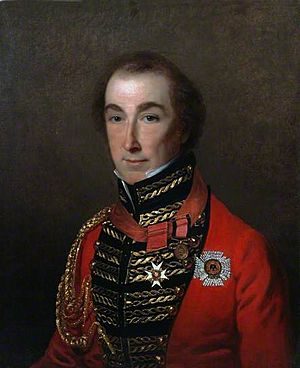Jasper Nicolls facts for kids
Quick facts for kids
Sir Jasper Nicolls
|
|
|---|---|

Sir Jasper Nicolls
|
|
| Born | 15 July 1778 East Farleigh, Kent |
| Died | 4 May 1849 Reading, Berkshire |
| Allegiance | |
| Service/ |
|
| Rank | Lieutenant General |
| Commands held | Madras Army Indian Army |
| Battles/wars | Second Anglo-Maratha War Peninsular War War of the Fifth Coalition Gurkha War |
| Awards | Knight Commander of the Order of the Bath |
Sir Jasper Nicolls (born 15 July 1778, died 4 May 1849) was a very important British Army officer. He rose through the ranks to become a Lieutenant General. He even served as the top commander, known as the Commander-in-Chief, of the British Army in India.
Contents
Early Life and Army Start
Jasper Nicolls was born in a place called East Farleigh in Kent, England. He went to school and later studied at Trinity College, Dublin in Ireland. In 1793, when he was just 15 years old, he joined the army as an officer in the 45th Regiment of Foot.
Adventures in the West Indies
Nicolls spent about five or six years serving in the West Indies, which are islands in the Caribbean Sea. During this time, he worked hard and was promoted to the rank of captain in 1799.
Serving in India
In 1802, Nicolls traveled to India. He worked as a military secretary and helper to his uncle, Major-General Oliver Nicolls. His uncle was a commander in the British Army in the Bombay area of India.
Battles in India
Nicolls joined the army led by Sir Arthur Wellesley, who later became the famous Duke of Wellington. This was during the Second Anglo-Maratha War (1803–1805). He was part of important battles like the Battle of Argaon and the Siege of Gawilghur in 1803.
Return to Europe
After the war in India, Nicolls went back home to England. He was promoted to major in 1804. The next year, his regiment joined a group of soldiers sent to Hanover, a region in Germany.
Fighting in South America
In 1806, Nicolls sailed with a group of soldiers to the Cape of Good Hope in South Africa. From there, they went to South America for a campaign in the Río de la Plata region. This included a difficult attack on the city of Buenos Aires in July 1807.
During the attack on Buenos Aires, Nicolls showed great bravery. His group of soldiers got separated from the main army. Even though they were surrounded, he fought back against the enemy and held his ground. He refused to give up his regiment's flags, which are very important symbols for soldiers. The general in charge, John Whitelocke, even mentioned Nicolls's brave actions in his official reports.
More Campaigns and Promotions
In 1807, Nicolls became the commanding officer of another regiment, the 14th Regiment of Foot. He then fought in the Battle of Corunna in Spain and took part in the Walcheren Campaign in 1809.
In 1811, he started working at the main army headquarters in London, called Horseguards. The next year, he became a senior officer in Ireland. Later in 1812, he returned to India as the Quartermaster-General, in charge of supplies and movements.
Success in the Gurkha War
In 1815, during the Gurkha War (also known as the Anglo-Nepalese War), Nicolls led his troops to capture a place called Almora. This helped the British take control of the Kumaon region.
High Command in India
Nicolls continued to rise through the ranks. In 1825, he became a commanding general of a division in the Madras Presidency in India. In 1829, he moved to command another division.
His career reached its peak when he was appointed Commander-in-Chief of the Madras Army in 1838. Then, in 1839, he became the overall Commander-in-Chief for all British forces in India. He held this very important position until he returned to England in 1843.
He was also given the honorary title of Colonel for different regiments, including the 93rd (Sutherland Highlanders) Regiment of Foot and the 5th (Northumberland Fusiliers) Regiment of Foot, which he held until he passed away in 1849.
Family Life
In 1809, Sir Jasper Nicolls married Anne Badcock. They had a large family together, with one son and eight daughters.

